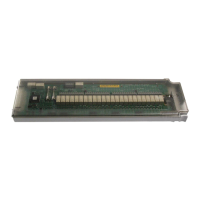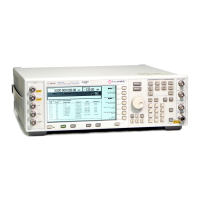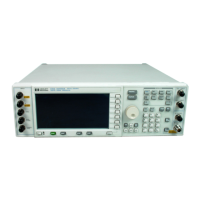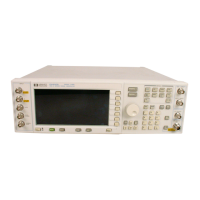Troubleshooting
RF Path Block Description (Frequency Generation, Level Control, and Modulation)
1-80
A30 Modulation Filter
The A30 Modulation Filter’s frequency output is from 100 kHz to 20 GHz. Frequencies below 3.2 GHz are
switched through the A30 Modulation Filter and are not filtered or modulated in the assembly. The A30
Modulation Filter provides level control, pulse modulation, amplitude modulation, and filtering for
frequencies 3.2 GHz and above. The ALC diode is used to maintain level control. With not bias applied to the
ALC diode, output goes to the maximum power level the circuit can produce. In pulse operation, the pulse
diode is biased on for an RF signal to pass through. If an A11 Pulse/Analog Modulation Generator is installed
and a bias is not applied to the pulse diode, no RF signal will pass through. Since the same A30 Modulation
Filter is used in all models, if an A11 Pulse/Analog Modulation Generator is not installed, circuitry on the
A30 Modulation Filter biases the pulse diode on.
In a 20 GHz signal generator the A30 Modulation Filter output is routed to the A24 High Band Coupler and
A25 High Band Detector. If a 40 GHz Doubler is installed, two A30 Modulation Filter outputs are routed to
the A27 40 GHz Doubler.
A27 40 GHz Doubler
The 40 GHz Doubler is used to produce frequencies between 20 and 40 GHz. The 40 GHz Doubler has two
inputs from the A30 Modulation Filter. One input is used for frequencies below 20 GHz and one for
frequencies above 20 GHz. Frequencies below 20 GHz pass through the A27 40 GHz Doubler. Frequencies
20 GHz and above are generated by doubling the A30 Modulation Filter’s 10 to 20 GHz input. After being
doubled, band pass filters are used to eliminate unwanted harmonics. The 40 GHz output is routed to the A24
High Band Coupler and A25 Detector.
A23 Low Band Coupler/Detector, A24 High Band Coupler,
and A25 High Band Detector
The function of the coupler is to couple off a portion of the RF signal. The detector is used to convert the RF
signal to a dc voltage. The dc voltage is then routed to the A10 ALC. The RF signal out of the A23 Low Band
Coupler/Detector is routed to the A30 Modulation Filter. The RF signal out of the A24 High Band Coupler and
A25 High Band Detector is routed to either the optional attenuator or the RF output connector. The A23 Low
Band Coupler/Detector is s single unit and the coupler and detector must be changed together. The A24 High
Band Coupler and A25 High Band Detector are two separate units and can be changed independently. The
A23 Low Band Coupler/Detector is used for frequencies 2 GHz and below. The A24 High Band Coupler and
A25 High Band Detector are used for frequencies above 2 GHz.
ALC Loop
The function of the ALC loop is to maintain power level accuracy by measuring the output power and
compensating for deviations from the set power level. The A23 Low Band Coupler/Detector and the A24 High
Band Coupler and A25 High Band Detector detect the output power level, compare the detected voltage to a
reference, and adjust the modulator diodes (located on the A8 Output and A30 Modulation Filter) to achieve
the desired power level.
A10 ALC
In ALC ON operation, the A10 ALC integrates the detected and reference voltages and adjusts the drive to
the modulator diodes until both the reference and detected voltages agree. The low and high band detectors
provide the detected voltage to the A10 ALC. The reference voltage is determined by the A18 CPU setting
DACs on the A10 ALC. The detected and reference voltages are the input to an integrator. When the inputs to
the integrator are equal the output ramps in either direction changing the modulator diode drive level. Once
the detected voltage equals the reference voltage the output of the integrator remains at a constant level.

